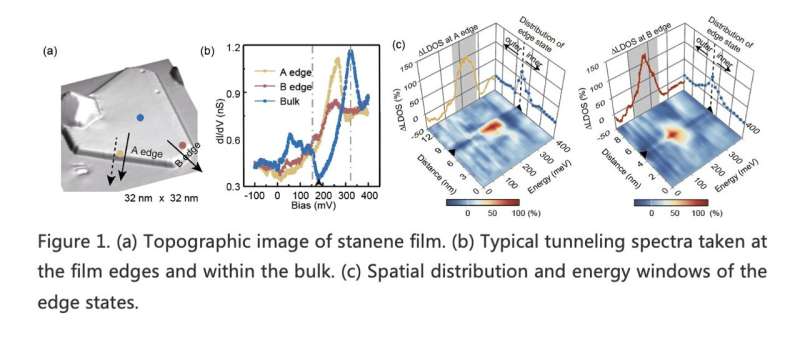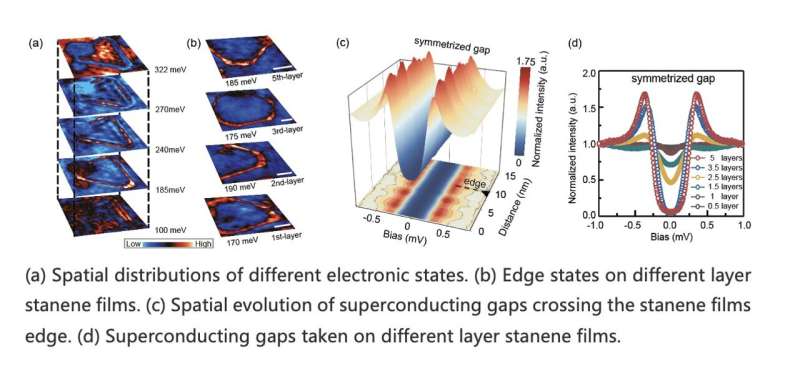June 16, 2022 feature
Study observes the coexistence of topological edge states and superconductivity in stanene films

Stanene is a topological insulator comprised of atoms typically arranged in a similar pattern to those inside graphene. Stanene films have been found to be promising for the realization of numerous intriguing physics phases, including the quantum spin Hall phase and intrinsic superconductivity.
Some theoretical studies also suggested that these films could host topological superconductivity, a state that is particularly valuable for the development of quantum computing technology. So far, however, topological edge states in stanene had not been reliably and consistently observed in experimental settings.
Researchers at Shanghai Jiao Tong University, the University of Science and Technology of China, Henan University, Zhengzhou University, and other institutes in China have recently demonstrated the coexistence of topological edge states and superconductivity in one to five-layer stanene films placed on the Bi(111) substrate. Their observations, outlined in a paper published in Physical Review Letters, could have important implications for the development of Stanene-based quantum devices.
"The present work is a latest step forward in our systematic research following our previous work published in 2015, which represented the first report on the successful growth of a stanene monoatomic layer (ML)," Jinfeng Jia, one of the researchers who carried out the study, told Phys.org. "The challenge has been, at that time, the Bi2Te3 substrate imposes a compressive strain to the stanene layer, leading to an unfavorable overlap between its conduction and valence bands."
Building on previous findings, Jia's team and other research groups worldwide have been trying to realize topological superconductivity in stanene placed on various substrates with larger lattice constraints than Bi2Te3, as these could retain the nontrivial topology of stanene. Yet so far very few had succeeded.
To build efficient quantum computing technologies based on stanene films, physicists will first have to identify a substrate that can be used to grow stable stanene with non-trivial topological properties and intrinsic superconductivity. This is what Jia and his colleagues set out to do in their recent paper.

"The ultimate goal of our recent paper is to achieve the topological superconductor in stanene, a single-element material system," Jia said. "Such a desirable substrate was identified by our more recent theoretical study, pointing to the Bi(111) substrate."
In their experiments, Jia and his colleagues collected measurements using scanning tunneling microscopy and spectroscopy at an ultralow temperature of 400mK. These methods allowed them to detect localized topological edge states on their stanene samples in the nanometer scale and to confirm the superconducting pairing in the material.
"Our first-principles calculations further confirmed the nontrivial topology of those films, and the vital importance of significant spin-orbital coupling provided by the Bi(111) substrate," Jia explained. "We also showed that hydrogen is indispensable in altering the growth mode to grow smooth and layer-by-layer."
The recent work by this team of researchers conclusively demonstrates the coexistence of topological edge states and superconductivity in stanene films. In contrast with other previous realizations of these states, in their sample these two properties are encompassed within a single-element system, rather than in a complicated heterostructure.
The short bilateral penetration lengths of the edge states observed by Jia and his colleagues are particularly favorable for the development of low loss conducting devices with dense edge channels. In addition, the stanene film platform identified by the researchers could enable the development of topological quantum computing devices based on fewer stanene layers.
"For the stanene/Bi (111) system, the next step is to identify the pairing symmetry of its superconductivity and to realize Majorana zero modes by creating boundaries for the closed loop edge channel," Jia added. "The target of our group, in the long term, is to realize the braiding operation of the Majorana modes and even push forward into topological quantum computing."
More information: Chenxiao Zhao et al, Coexistence of Robust Edge States and Superconductivity in Few-Layer Stanene, Physical Review Letters (2022). DOI: 10.1103/PhysRevLett.128.206802
Journal information: Physical Review Letters
© 2022 Science X Network





















